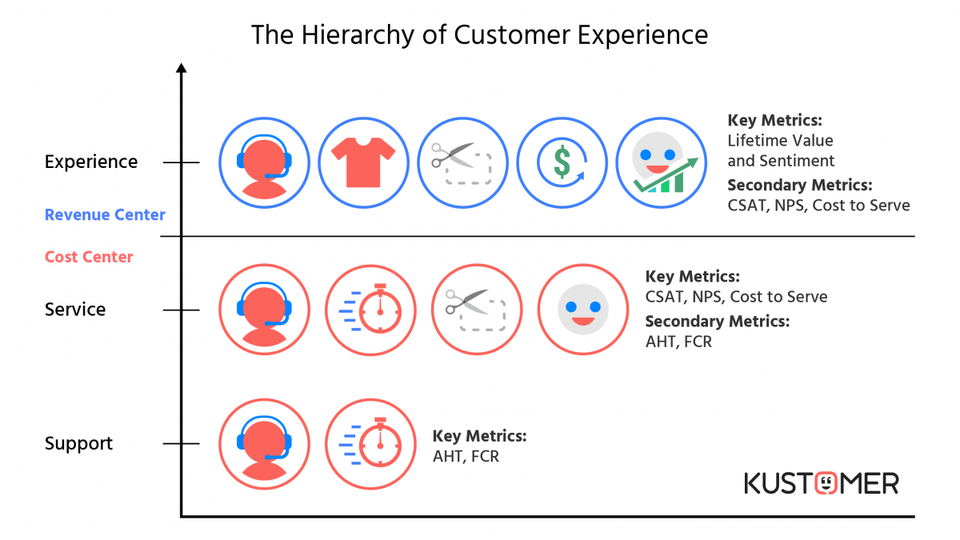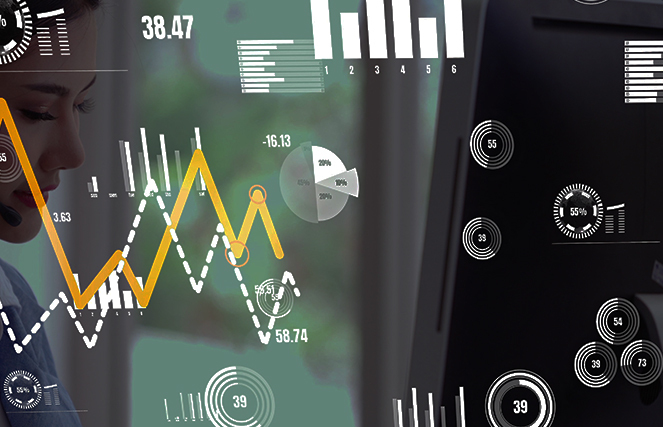So much data, so little time.
We live in a world of big data, where endless amounts of data can be stored in the cloud at a very considerable cost. This may sound great for customer support agents and managers. But too much information and not enough time to sort through it all can be a huge drawback too.
It is, therefore, necessary to choose the right customer service metrics. It is crucial to take into account the types of metrics available to get a more holistic picture. More importantly, it will give you a way to focus on the metrics that matter! Multiple issues within an organization can be chalked up to the same fundamental problem, i.e., focusing on and practicing the wrong combination of metrics. Help desk metrics may seem like a minor consideration, but it reflects every aspect of an organization and its success.
Organizations are hard-wired to believe that quantifying performance in terms of numbers is a sure way to drive success. This is especially true for customer support teams and individuals because they work at the forefront of your organization. If your company fails to find out the key trends, it is an alarm that you need to refurbish your overall support with newer and useful help desk metrics.
Shortsighted metrics don’t let you prioritize long-term and sustainable growth. So, if your company’s customer support department is struggling, it is almost because you’re using the wrong metrics to judge its performance. Here’s a guide to help you get started. In this piece, we’ll cover:
- Various metrics used to measure customer support. Where do these customer support metrics fall short, and what are they best for?
- The mindset that organizations need to have is to change their approach towards help desk metrics and quantify the right metrics.
Let’s get started!
Help Desk Metrics vs. KPIs
Before we begin, let’s quickly take a look at the difference between KPIs and metrics. Despite their similarities, they’re both different customer support objectives. Help desk metrics are the numbers or stats that you measure daily or weekly. Help desk metrics feed into your overall KPIs, and they tend to remain static.
However, KPIs will get you more specific goals that you can adjust based on the overall performance. Let’s say you identify some patterns in your metrics. Now what you do with these patterns will indicate your business’s CSAT rates for the next quarter or so.

Collecting concise help desk metrics creates a rich tapestry of data to interpret and empathize with customer behavior.

If you do not have proper metrics in place, it will become impossible for you to assess your team’s efficacy. So, the question goes: “How exactly can you be sure that you’re analyzing the most relevant data metrics for your support operations.” Help desk metrics inform your customer support experience and can reveal potential problems. These internal performance metrics highlight new opportunities and features for your product.
Transparency occurs naturally once you implement clear and measurable goals. It will empower your team to take strategic action to improve their overall support experience for customers.
Help desk Metrics and Customer Lifetime Value
Can we all agree upon the fact that the type of help desk metrics you measure directly reflects your customer’s lifetime value? In fact, customer lifetime value itself is a key metric for customer experience-oriented businesses.
Support used to be simplified. Customers (with queries) would contact your business over the phone, and the businesses would solve their problems and answer their questions. Now, support has gotten a lot more complicated, and the metrics we use to assess have not kept up to match our new omnichannel world. In today’s modern services landscape, lifetime value takes the top spot.

The customer support business is constantly evolving, and if you want to ace your customer support, you need to master it. Let’s take a look at this list of top help desk metrics and ensure that your help desk is performing at maximum impact.
10 Help Desk Metrics That You Must Track as Per The Industry Standard
1. Number of New Tickets
Number of new tickets is the most basic help desk metric to track. It does not require any complex procedures. Just pick a help desk that lets you view the total count of your total tickets. This metric simply means the volume of incoming tickets in a given timeframe.
This can help you find out how many tickets your team is receiving and how quickly your team must work to keep up. It could be based on day, week, month, quarter, or even year. Even a monthly ticket inflow report provides valuable data for any company. The number of incoming tickets also helps you allocate resources accordingly. You can use these insights to break down further the number of tickets that your team is receiving per support agent. This will help you with future scheduling and hiring decisions.
2. Ticket Volume Via Channel
Measuring just the incoming tickets is not enough. You need to bifurcate them and break them down according to what channels they’re coming from—for example, phone, email, social media, or chat. Once you know which channels are the most popular, you’ll be able to allocate resources to meet customer demand. You can also focus on training agents to efficiently handle tickets on these channels to be more efficient.
3. Tickets By Type
You must know the nature of your ticket types and customer requests. It is essential to the development of your business’s support offerings. It provides a digestible visual snapshot of the main requests your agents deal with over a fixed time period.
These types would differ from business to business and entirely depend on the business’s size, niche, model, and industry. You will get an accurate overview of your most prominent ticket types by tracking everything periodically. It allows you to prepare support resources or strategies accordingly. On the other hand, it’ll help you increase output, improve your service levels, and ultimately increase customer loyalty.
4. Support Tickets: Opened vs. Solved
Another help desk metric that you should be looking at is the number of tickets solved. Your helpdesk’s open tickets and closed tickets trend lines should be parallel. By looking at these metrics every day, you can make sure that your team is keeping up with the demand and that you can identify trends in ticket volume.
For example, if the resolution rates are consistently behind, you may need to hire more staff or look for ways to increase efficiency. If you observe a sudden spike in new tickets, your helpdesk can alert you to service delivery issues or other roadblocks that need attention.
5. Resolution Time
Resolution time simply represents the average amount of time it takes your customer support team to settle a case once it is opened.
POV: Your customers lead busy lives, so you need to ensure that your support experience is comfortable and quick.
An increase in resolution times can be due to multiple factors. This may include a lack of suitable tools, poor ticket logging workflow, and so on. Quick resolutions to problems equal happy customers. And happy customers play a crucial role in determining your overall CSAT score.
6. Ticket Distribution
If you are using customer support software, you can add category tags to your tickets. This will help you identify specific topics or products that result in more tickets than others. Support managers must look into the process of how inquiries are distributed across different topic areas.
As a support manager, you can determine any correlation between your CSAT scores and low first-time responses. Monitoring and adjusting your distribution can help you save a recurring problem with your services. This can illuminate where you might need to add or expand on existing knowledge base content.
7. Response Time
Average response time is the period between a support request being created and the first documented action taken by an agent. The longer this takes, the more you jeopardize customer satisfaction. Most people expect an acknowledgment that someone has started looking into the issue in a considerable amount of time after submitting their request.
The wait time of the requester is the cumulative time that a support request is unresolved while an issue is being worked on. While facing a ticket spike, it is a good idea to manage expectations for your help desk customers. If you are transparent about longer wait times instead of hiding it, people will usually be understanding.
8. First Contact Resolution Rate
First contact resolution (FCR) is when a customer’s support request is resolved in one service interaction. The first contact resolution rate measures how frequently you can solve tickets within the span of one session. It is essential to understand that this metric determines how effective your agents’ problem-solving abilities are and whether they’ve received enough training.
9. Customer Satisfaction Score (CSAT score)
Customer satisfaction score tells you whether your customers are happy with the service they’re receiving at the moment. That is great, but you’re forgetting one thing. i.e., the value of your customers’ behavior after you’ve interacted with them!
CSAT and NPS capture the tiny minority of customers who take your survey. Plus, most of the time, they’ll only speak to the interaction they just had.
For example, if you’re a tech retailer and a customer has had problems with their new monitor. If they have to call you a dozen times to get it fixed, then they are not satisfied with your brand. There is a good chance they’ll talk about their frustrating experience on social media or in closed circles. For such an experience, customers won’t be satisfied even if their issue gets resolved. Because they had to wait for a long time to get their issue resolved. Hence, you may not receive a good CSAT score, which can be alarming for you and your team.
10. Agent Satisfaction
Agent satisfaction is one of the most critical help desk metrics and is as important as customer satisfaction. It is one of the cornerstones of a productive, cohesive, and attentive customer support. After all, happy employees create happy customers.
You need to ensure that every member on your team is working to their full potential. It is evident that if your agents are overworked or underappreciated, they won’t be able to perform their best. This will also affect all the above metrics.
Measuring the Right Help Desk Metrics = Delighted Customers
Help desk metrics offer rich insights into two crucial aspects:
- How customers perceive your support
- How well your team is performing to meet ever-rising customer expectations
The metrics mentioned above can help you determine whether your business is on the right track. You must analyze qualitative data accurately and understand the complete story behind these hefty numbers.
Too much data is a bit difficult to manage, but it is a boon too. Customer data hides more than it reveals, and DeskXpand is here to help you make sense of your data. With our intuitive customer service software, your business can measure the help desk metrics that matter and offer delightful support every single day.
DeskXpand’s exceptional help desk metrics help businesses provide quick resolutions by measuring the metrics that matter and offering delightful solutions. It is an automated, omnichannel solution that caters to all business needs. We are an ISO27001 certified development company with 14+ years of development experience. Make sure you don’t miss checking out DeskXpand’s live demo.







